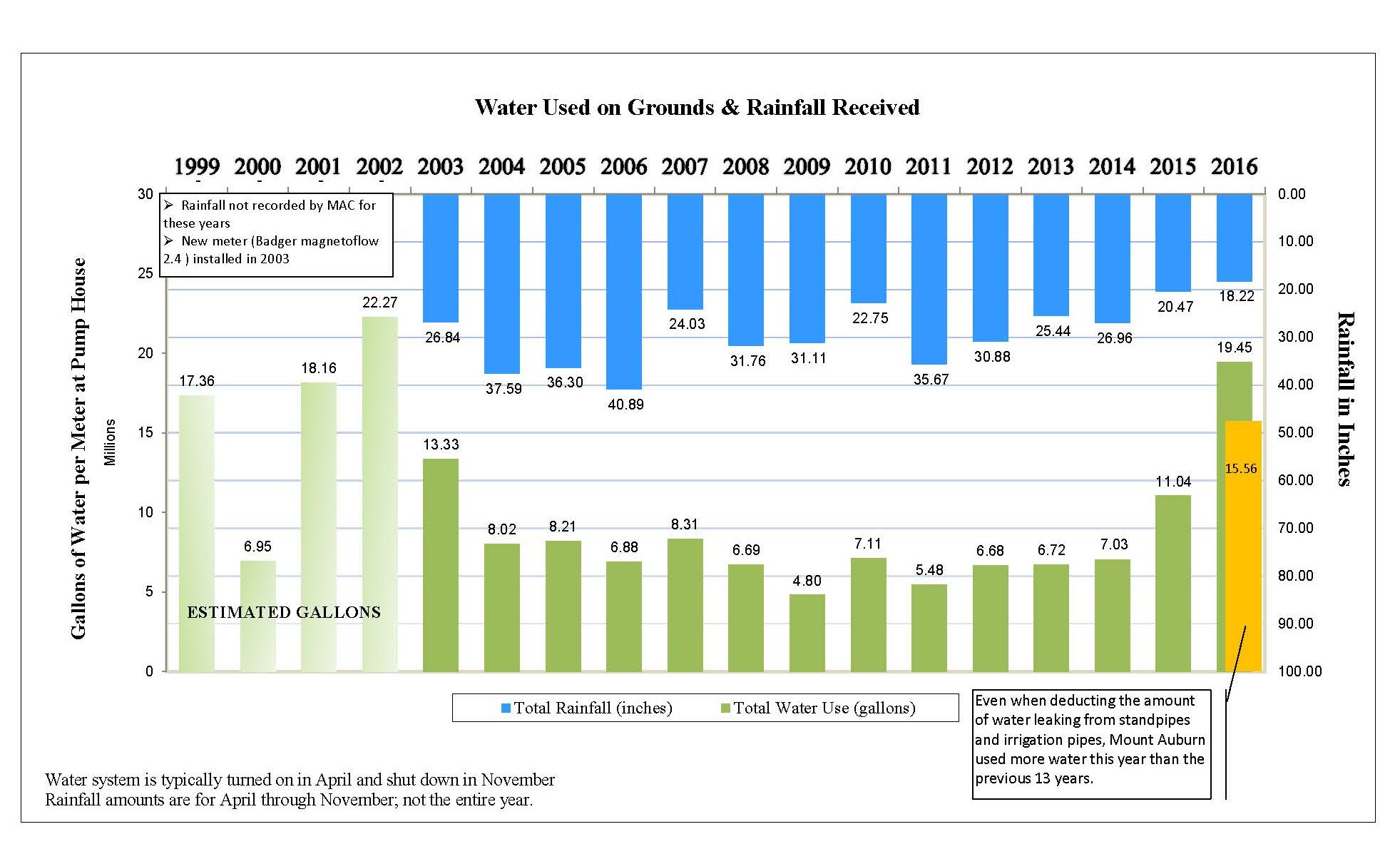Ripple Effects of a Drought
 The effects of the unprecedented drought that Mount Auburn (and most of Massachusetts) experienced during the 2016 growing season will be felt for several years. The extremely dry conditions triggered an extended dormancy period for turf grass. Respite didn’t arrive until several fall rain events returned green grass to the landscape. The drought also created additional stress to trees and shrubs, as moisture was no longer available in the soil and microbial activity stalled. The danger of limb drop became more pronounced. The loss of a large limb from a mature oak revealed this over the summer. The full effect of the drought, however, won’t be fully realized until next spring as we begin to see if trees and shrubs will be slow to leaf out, or in fact, don’t leaf out at all. It was a challenge to meet the irrigation demands of the plant collections in 2016 through the limited and antiquated irrigation infrastructure. Nearly all 24 hours of every daily cycle were needed to shift resources and alleviate water pressure issues.
The effects of the unprecedented drought that Mount Auburn (and most of Massachusetts) experienced during the 2016 growing season will be felt for several years. The extremely dry conditions triggered an extended dormancy period for turf grass. Respite didn’t arrive until several fall rain events returned green grass to the landscape. The drought also created additional stress to trees and shrubs, as moisture was no longer available in the soil and microbial activity stalled. The danger of limb drop became more pronounced. The loss of a large limb from a mature oak revealed this over the summer. The full effect of the drought, however, won’t be fully realized until next spring as we begin to see if trees and shrubs will be slow to leaf out, or in fact, don’t leaf out at all. It was a challenge to meet the irrigation demands of the plant collections in 2016 through the limited and antiquated irrigation infrastructure. Nearly all 24 hours of every daily cycle were needed to shift resources and alleviate water pressure issues.
Mount Auburn’s superintendent of grounds already knows that many shrubs under perpetual care will need to be replaced, and special garden areas, designed and planted in 2016 at Beech and Central Avenues and Harvard Hill will require replacement plants as well. Throughout the Cemetery, more new gardens areas were created than in a typical year. Irrigation systems were set-up for those new gardens, but even with irrigation in place, some plants will not survive the stress of drought.. Even in perfect conditions, plant mortality is always anticipated, but these conditions were far from perfect.
2016 was a ‘perfect storm’ of issues. In the early spring, Mount Auburn experienced defoliation issues from winter moth, then came the persistent drought. Later in the summer, compromises to the integrity of the irrigation system impacted watering strategies.
Next year, arborists anticipate the beech trees (Fagus species) will show an advancement of decline. Also, they expect problems with dogwoods (Cornus florida and c. kousa). Even trees that have been growing for over a decade may show signs of drought stress like leaf die-back.
 In addition to plants showing signs of stress, Mount Auburn may have a new stressor. Mount Auburn pumps water for irrigation of select garden areas and plants from a well that is 53 feet deep, located at the north basin of Auburn Lake. We may be back under the purview of the Department of Environmental Protection (DEP) regarding withdrawal of that well water, which is part of the aquifer that extends “north of Fresh Pond in Cambridge beneath the Charles River to North Brighton and beyond” (as reported in Mount Auburn Cemetery Water Conservation and Drought Management Plan, 2003, written in association with Emery & Garrett Groundwater, Inc. Waterville, ME). Mount Auburn is not yet certain if a new water withdrawal permit is required, but we do know the importance of continuing with our record keeping of water use.
In addition to plants showing signs of stress, Mount Auburn may have a new stressor. Mount Auburn pumps water for irrigation of select garden areas and plants from a well that is 53 feet deep, located at the north basin of Auburn Lake. We may be back under the purview of the Department of Environmental Protection (DEP) regarding withdrawal of that well water, which is part of the aquifer that extends “north of Fresh Pond in Cambridge beneath the Charles River to North Brighton and beyond” (as reported in Mount Auburn Cemetery Water Conservation and Drought Management Plan, 2003, written in association with Emery & Garrett Groundwater, Inc. Waterville, ME). Mount Auburn is not yet certain if a new water withdrawal permit is required, but we do know the importance of continuing with our record keeping of water use.
From 2003 to 2009, Mount Auburn reported annual water use to the DEP because the aquifer from which Mount Auburn draws its water is a Massachusetts resource, not a Mount Auburn one. In 2010, after several years of irrigation improvements including switching to low-flow sprinklers and reducing irrigation frequency, Mount Auburn no longer needed a permit to withdraw water from the aquifer and report to the DEP. In 2016 however, during the droughts of ‘extreme’ and ‘extraordinary’ categories, Mount Auburn pumped more water from the well than was typical to keep plants alive and water in the ponds at safe levels for the fish populations. As water warms up and pond levels are lowered by evaporation, the oxygen levels are also depleted which may result in fish kills. Mount Auburn has experienced fish kills in the past; therefore, water is added into the ponds to prevent that horrible situation from occurring.
We also experienced a problem this year with a pressure gauge on the well pump and consequently pumped more water than was actually required for irrigation. Due to the high pressure of water going through the old pipes, several leaks below ground occurred. In a typical year, those leaks are noticed because water bubbles up to the surface. In such droughty conditions, the bubbling up did not occur; therefore, it took longer to locate and fix the leaking pipes. Consequently, we’re estimating a higher leak rate of 30% rather than the typical 20% in most recent years. The water meter cannot determine what water is being leaked and what water is used for irrigation, so it appeared that all pumped water was used for irrigation. In fact, 4 to 6 million gallons went directly back into the earth recharging the aquifer. If the ‘leaked’ water is taken into account, then Mount Auburn used between 14 and 16 million gallons of water, which is still more than typical years. The full metered amount was 19.5 million gallons from the April to November season.
According to National Oceanic and Atmospheric Administration (NOAA) and The Weather Channel (TWC), the Northeast has equal chances of seeing above- or below-average precipitation and temperatures during the winter of 2017. So, it’s anyone’s guess what the weather will be like next year – warmer, perhaps, wetter? Let’s hope for gentle spring rains.
Leave a Reply